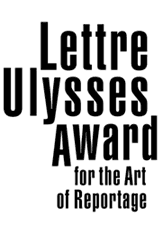
The Art of Reportage
The genre of literary reportage is situated between journalism and literature. It has in common with journalism its relation to actuality. Reportage refers to cultural and social reality, past developments, and current affairs.
Good journalism interprets events by contextualizing elements such as historical background and causality, presenting readers with material for a more enlightened interpretation of world affairs.
The imperatives of mass media, their standardized patterns, their competitiveness, their permanent quest for the latest sensation, and their view of information as a commodity, impose tight limitations on the journalist's radius of action. Journalism often has to isolate facts and events, sensationalizing and glamorizing them through personification. Likewise, much of today’s journalism oversimplifies complex situations and their backgrounds, favoring a trivial and partial understanding. Furthermore, it is compelled to use a language appropriate for the busy and undiscerning reader. As a result, it can hardly avoid providing stereotyped interpretations of reality.
Literature, on the other hand, is born of imagination, invention, and fantasy. Literature need not be directly related to real life. Its protagonists exist in a fictional sphere. Literature embraces images, metaphors and allegories, and is nourished by the poetic impact of language. Literature uses rhythm. Literature can use cuts and montages like a film. Literature draws energy through condensation. Literature touches dimensions of actuality which journalism avoids—such as psychology, visions and introspection, emotion and imaginary reality—and is sensitive to the effects of geography on human modes, behaviors, and traditions.
In earlier times, newspaper journalism—the written report—was the medium for conveying the unknown, describing events which often happened far away. The reports had to communicate a high level of credibility. Attempting to transcend its own limitations, newspaper journalism was expected to deliver a depiction of events that the reader couldn't experience personally. The journalist was a substitute eye-witness. Consequently, his role was to stimulate the reader’s imagination, evoking a complete, multifaceted, and lively image of the events reported.
Later, photography entered the realm of delivering representations of real life in accompanying written journalism. Subsequently, photography gained a journalistic value of its own, ranging from serious photo-reportage to sensationalist photo-journalism.
Meanwhile, we are witnessing a process of historical change in the field of journalism. The function of delivering representational images of distant situations has been widely passed on to television, whose influence is prevailing over written journalism.
Today, audiovisual media has become a powerful and dominant force, and images seem to have become synonymous with authentic reporting. In this context, language has deteriorated into a mere auxiliary element, accompanying the image content. In TV, it is the image flow which defines the length and speed of the text. Images may not last longer than a few seconds, and texts should not be long or complicated.
We are exposed to an overwhelming flood of images which trigger powerful sensations. We have to adapt ourselves to the speed of the image flow. Thus, TV diminishes the viewers’ habit of, and capacity for concentration, manifesting itself in short attention spans.
However, life as a world citizen, on a planet with diverse interdependencies of increasing complexity, demands much more. This world requires many competencies of people: to integrate diversity, to comprehend heterogeneity, to reconcile different layers of information, to interpret context, and to appreciate historical background.
In terms of market and finance, technology and media, or mass culture and tourism, the process of globalization seems to be irreversible. This process creates a complex matrix of relations. Paradoxically, the ruling rhetoric of globalization is often characterized by a critical oversimplification of reality and claims that a homogeneous world will emerge following the imperatives of development. The power of simplified versions of events upon our thinking explains why we are frequently confronted with bolts from the blue. Massacre in Rwanda … Collapse of the Soviet Union … Fall of the Wall … War in Yugoslavia … Fundamentalist attacks in Algeria … Afghanistan … September 11th —unremittingly, unexpected and powerful historical events spring upon the world stage. Shocks! And nearly no one saw it coming. How could this have happened? Later, we have to sort it all out. And sometimes choose between war and peace.
This profound naiveté is basically due to two reasons. Firstly, we lack knowledge of the world in all its diversity, its cultures, its religions, its languages, its traditions, and mentalities. Secondly, we are also accustomed to a sometimes simple-minded manner of classifying the world: "The Islamic world," "good and evil”, etc.
If it is true that our world will not be unified automatically through globalization; if it is also true that the major conflicts of our times will certainly not be solved through a "Clash of Civilizations," it follows then that we need a deeper, more profound knowledge and understanding of the diverse cultures. The world requires a "Politics of Curiosity" which will contribute to genuine "Dialogues of Civilizations."
Reportage writers, with their immersion in the subject, bring unknown, hidden or forgotten realities and intricacies to light. By witnessing with their own eyes and collecting and consolidating a mass of information, in forming a picture of the whole, the reportage writer can deliver a greater degree of accuracy than is generally possible with other media formats. This is what gives reportage writing its significance and authority.
Reportage writing, however, is not limited to merely documenting events. The combination of reportage with the techniques and subjects of literature allows for the creation of complexity, density, depth and multiple layers. In the field of reportage, creative nonfiction makes use of literary writing by taking advantage of its refinement of composition and its devices of introspection, interior monologue, dialogue, and polyphony. Literary reportage can draw on the visual arts, using changes of perspective, tempo and mood, cuts and montages, and it can make use of metaphors, parables, and allegories. Thus, reportage can be transformed into an art—the Art of Reportage.
